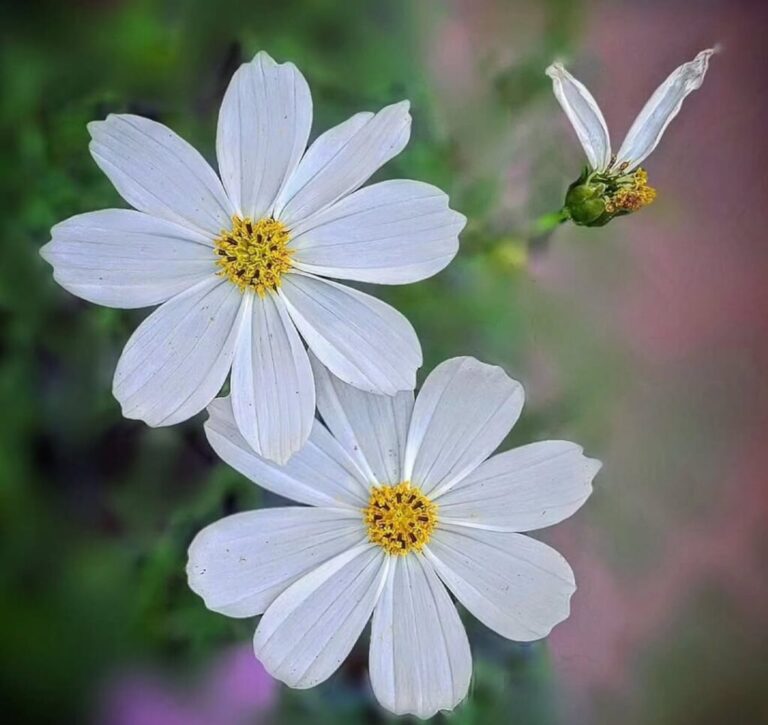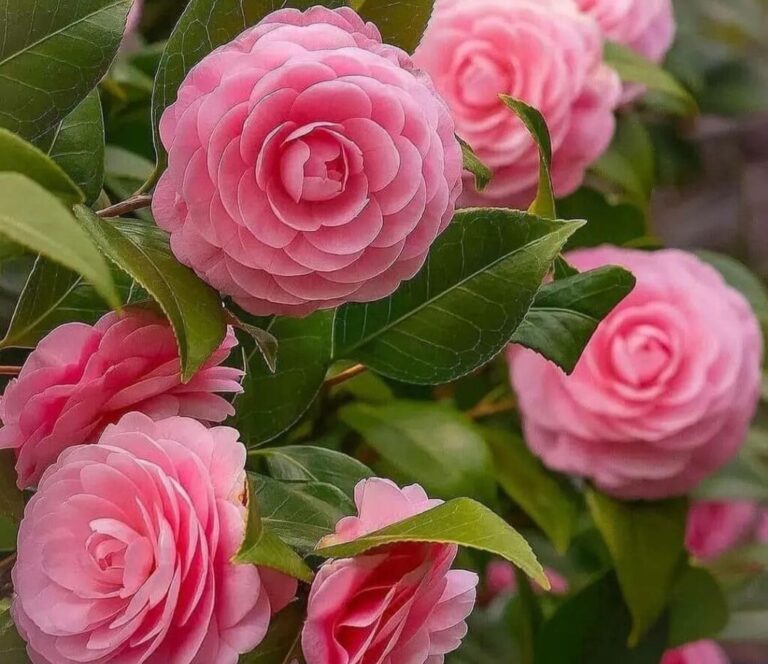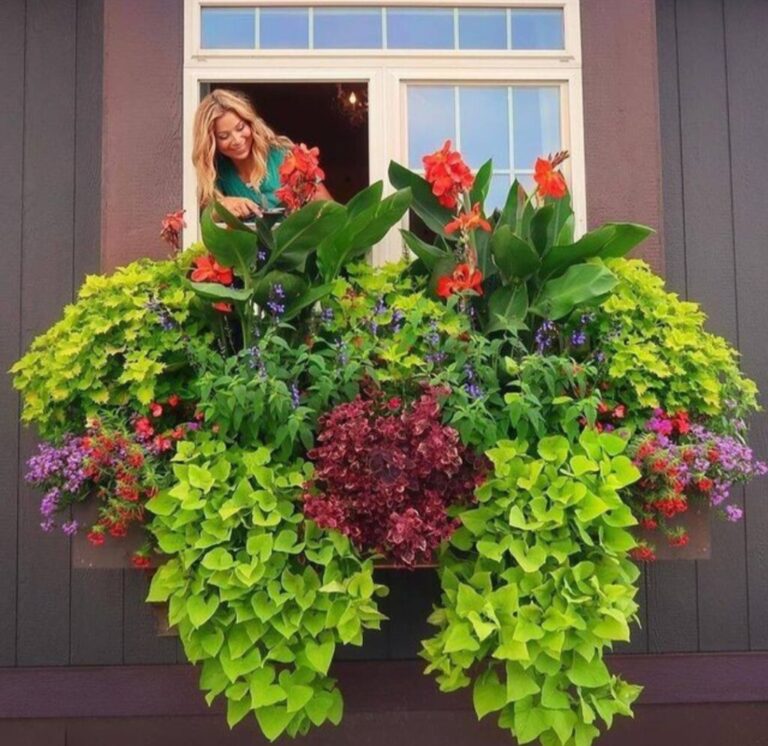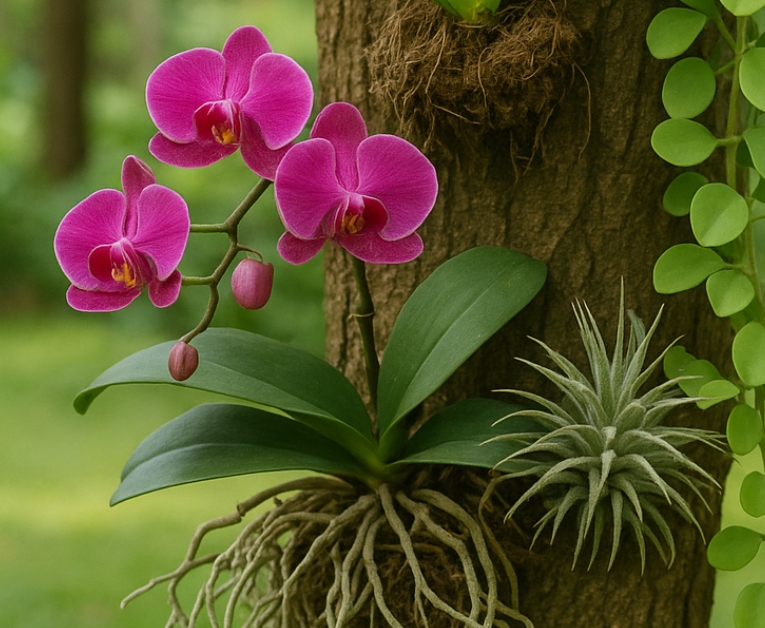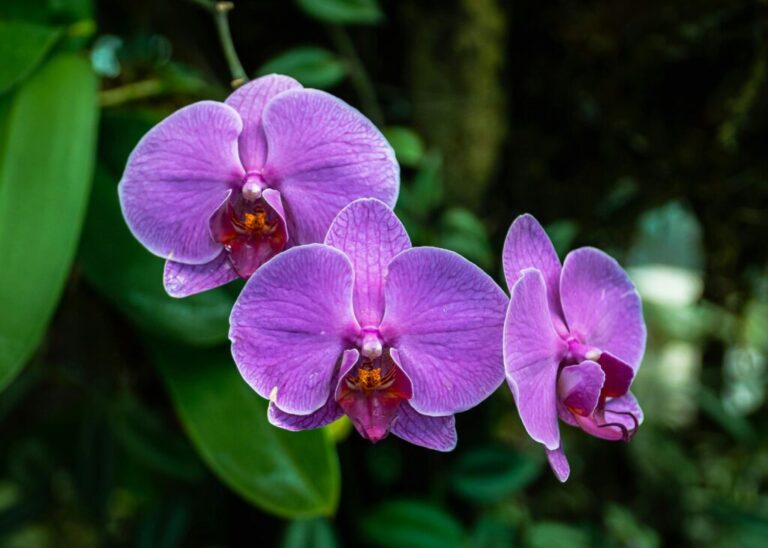Calathea makoyana, also referred to as the Peacock Plant, is a well-liked tropical plant that is appreciated for its magnificent leaf and distinctive features. It is a member of the Marantaceae family and originates from the Brazilian rainforest. In appropriate conditions, the plant is frequently grown as a houseplant or in shady outdoor gardens due to its high appreciation for ornamental value.
The remarkable patterns on the leaves of the Peacock Plant, which resemble the exquisite feathers of a peacock, gave rise to its name. The oval-shaped leaves have striking patterns and are coloured a vivid green. While the undersides of the leaves have a rich purplish-red colour, the upper sides of the leaves feature alternating bands of dark and light green. The plant’s look is visually appealing due to the blend of colours and patterns.

Benefits of the Peacock Plant:
Aesthetically pleasing: The Peacock Plant is cherished for its attractive foliage, adding a touch of tropical beauty to any indoor space.
Air purification: The plant filters and purifies the air by removing harmful toxins and volatile organic compounds (VOCs), contributing to a healthier indoor environment.
Stress reduction: Indoor plants, including the Peacock Plant, have been shown to reduce stress levels and promote a sense of calm and relaxation.
Peacock varieties
The term “Peacock Plant” typically refers to Calathea makoyana, which is known for its distinctive foliage. However, if you’re interested in exploring other Calathea varieties that showcase similar beauty and unique leaf patterns, here are a few popular options:
Calathea ornata (Pinstripe Calathea): This variety features dark green leaves with pink or white stripes running parallel to the leaf veins, giving it a pinstripe-like appearance.
Calathea roseopicta (Rose Painted Calathea): This species encompasses several cultivars, each with its own leaf patterns and colours. The leaves often display combinations of dark green, burgundy, pink, and cream with intricate markings.
Calathea lancifolia (Rattlesnake Plant): This variety has long, lance-shaped leaves with dark green coloration and wavy, light green patterns that resemble a rattlesnake’s skin.
Calathea orbifolia: Known for its large, round leaves, Calathea orbifolia features light green stripes on a dark green background. The leaves have an elegant and striking appearance.
Calathea zebrina (Zebra Plant): This variety has elongated leaves with deep green coloration and distinctive zebra-like stripes in shades of silver or pale green.
Calathea medallion: With its rounded, glossy leaves, Calathea medallion showcases a rich blend of dark green, silver, and purple hues, creating a medallion-like pattern.
Light requirements:
The Peacock Plant (Calathea makoyana) prefers medium-to-bright indirect light. Here’s a breakdown of its light requirements:
Indirect light: The Peacock Plant thrives in areas with indirect sunlight. Direct sunlight can be too intense and may scorch the leaves. Place the plant in a location where it receives filtered sunlight or partial shade throughout the day.
Bright but indirect light: While the Peacock Plant can tolerate lower light conditions, it will appreciate bright indirect light. A spot near a north-facing window or a few feet away from an east- or west-facing window can provide the ideal amount of brightness without direct exposure to the sun’s rays.
Light intensity: The Peacock Plant benefits from consistent and moderate light levels. Avoid exposing it to sudden or drastic changes in lighting conditions, such as moving it from low light to intense direct light, as this can stress the plant.
Light duration: Ideally, the Peacock Plant should receive 10–12 hours of light per day. However, it’s important to note that it also requires a period of darkness for proper growth and rest. Providing a natural day-night cycle is crucial for the plant’s overall health.
If you find that the plant’s leaves are losing their vibrant colour or developing brown spots, it could be an indication that it is receiving too much direct light. On the other hand, if the leaves start to curl or become pale, it may suggest that the plant is not receiving enough light. Observing and adjusting the lighting conditions accordingly will help maintain a healthy and beautiful Peacock Plant.
Temperature and humidity
The Peacock Plant (Calathea makoyana) has specific temperature and humidity requirements to thrive. Here’s what you need to know:
Temperature:
Ideal temperature range: The Peacock Plant prefers average room temperatures between 65 and 80°F (18 and 27°C). It can tolerate slightly lower temperatures but should be kept away from cold draughts or drastic temperature fluctuations.
Avoid cold draughts: Place the plant in a location where it is protected from draughts, such as near windows, doors, or air conditioning vents. Cold draughts can cause stress for the plant and lead to leaf damage.
Winter temperatures: During the winter months, when indoor heating may affect the temperature, it’s important to maintain a suitable environment for the Peacock Plant. Avoid placing it near heat sources that could cause the air to become excessively dry.
Humidity:
High humidity preference: The Peacock Plant is native to rainforests and thrives in high-humidity environments. It appreciates humidity levels of 50% or higher.
Increasing humidity: There are several ways to provide adequate humidity for the Peacock Plant:
Use a humidifier: Place a humidifier near the plant to increase moisture levels in the air.
Pebble tray: Set the plant’s pot on a tray filled with water and pebbles. Ensure that the bottom of the pot does not touch the water. A humid microenvironment develops around the plant as the water evaporation process takes place.
Regular misting: Mist the leaves with water using a spray bottle once or twice a day, especially during dry periods or in heated rooms.
Grouping plants: Clustering multiple houseplants together can create a localised humid environment as plants release moisture through transpiration.
Bathroom or kitchen location: These areas typically have naturally higher humidity levels, so placing the Peacock Plant in these rooms can be beneficial.
Monitoring the humidity levels in your home and taking steps to increase humidity as needed will help maintain the Peacock Plant’s lush foliage and prevent issues such as leaf browning or curling, which can occur in dry environments.
Remember to strike a balance with temperature and humidity, avoiding extremes in both cases, to ensure the optimal growth and well-being of your Peacock Plant.
Soil and Watering
Soil and watering are essential factors to consider for the proper care of the Peacock Plant (Calathea makoyana). Here’s what you should know about the soil requirements and watering routine for this plant:
Soil:
Well-draining soil: The Peacock Plant prefers a well-draining soil mixture that retains moisture without becoming waterlogged. It is recommended to use a peat-based potting soil or a mixture of peat moss, perlite, and organic matter.
Soil pH: The ideal pH range for the Peacock Plant is slightly acidic to neutral, around 6.0 to 7.0. Maintaining the appropriate pH level helps the plant absorb nutrients effectively.
Avoid compacted soil: Ensure that the soil is loose and not compacted, allowing for proper root aeration and drainage. Compacted soil can lead to waterlogging and root rot.
Watering:
Keep soil consistently moist: The Peacock Plant prefers to have consistently moist soil, but not overly wet. Allow the top inch (2.5 cm) of soil to dry out slightly between waterings.
Water quality: To avoid shocking the roots of the plant, use water that is at normal temperature.Ideally, use filtered or distilled water, as the Peacock Plant is sensitive to chemicals and minerals present in tap water.
Watering frequency: The frequency of watering depends on factors such as temperature, humidity, and the size of the pot. As a general guideline, water the plant when the top inch of soil feels slightly dry. It’s important not to let the soil get too wet or dry out completely.
Watering technique: Water the soil evenly until water starts to drain out of the bottom of the pot. Discard any excess water that accumulates in the saucer or tray to prevent the plant from sitting in standing water.
Avoid overwatering. .Root rot and other moisture-related issues might result from excessive irrigation. It’s better to slightly submerge than overwater the Peacock Plant.
Adjust watering during seasons: During the active growing season (spring and summer), the Peacock Plant may require more frequent watering. In contrast, reduce the frequency of watering during the dormant period (fall and winter).
Observing the moisture levels in the soil and adjusting the watering frequency accordingly is crucial for the plant’s health. It’s important to find the right balance to prevent both underwatering and overwatering, as these can cause stress and damage to the Peacock Plant.
Remember to take into account the specific environmental conditions in your home, such as temperature and humidity, as they can influence the plant’s water requirements. Keep a close eye on the soil’s moisture content and make necessary adjustments to your watering schedule.
Fertilisation
Fertilisation is an important aspect of caring for the Peacock Plant (Calathea makoyana). Here are some guidelines for fertilising this plant:
Fertiliser type: Use a balanced, water-soluble fertiliser specifically formulated for houseplants. Look for a fertiliser with equal or balanced N-P-K (nitrogen-phosphorus-potassium) ratios, such as a 10-10-10 or 20-20-20 formulation. Alternatively, you can use a specialised foliage or indoor plant fertiliser.
Fertilising frequency: During the active growing season, which is typically spring and summer, fertilise the Peacock Plant every 2-4 weeks. This provides a steady supply of nutrients to support growth and foliage development. Reduce or stop fertilisation during the plant’s dormant period in the fall and winter.
Dilution and application: Follow the instructions on the fertiliser package for proper dilution ratios. Generally, it is recommended to dilute the fertiliser to half the strength recommended for houseplants. Apply the diluted fertiliser to the soil around the base of the plant, avoiding direct contact with the leaves.
Avoid overfertilization: Overfertilizing the Peacock Plant can cause salt buildup in the soil, leading to root burn and other problems. It’s better to err on the side of caution and slightly under-fertilise, especially if you are unsure about the dosage.
Flush out excess salts: To prevent salt accumulation in the soil, periodically flush the soil with plain water. Water the plant thoroughly, allowing water to flow freely through the drainage holes, which helps leach out any accumulated salts.
Organic alternatives: If you prefer organic options, you can use organic fertilisers like compost or well-decomposed manure. Apply them following the package instructions or guidelines for houseplants.
Propagating
Propagating the Peacock Plant (Calathea makoyana) can be done through division. Here’s a step-by-step guide on how to propagate your Peacock Plant:
Prepare the parent plant: Choose a healthy and mature Peacock Plant as the parent plant for propagation. Water the plant a day or two before propagating to ensure that the soil is slightly moist but not overly wet.
Gather the necessary tools: Prepare a clean pair of sharp pruning shears or a clean, sharp knife. You will use this tool to divide the plant.
Select a division point. Identify a suitable spot on the parent plant where you can make a clean division. Look for natural separations or sections with their own set of leaves and roots.
Divide the plant: Carefully remove the parent plant from its pot. Gently tease apart the root ball to separate the desired section. Make sure that each division has an adequate number of leaves and a healthy root system.
Trim and treat roots: Trim any damaged or unhealthy roots from the divisions using clean, sharp pruning shears or a knife. This encourages the development of new, healthy roots. If desired, you can also apply a rooting hormone to the cut ends of the divisions to promote root growth, although it’s not necessary for the Peacock Plant.
Plant the divisions: Prepare small individual pots with well-draining potting soil. Create a small hole in the soil for each division and gently place the division into the hole, ensuring the roots are covered. Press the soil gently around the base of the division to secure it.
Provide suitable conditions: Place the newly potted divisions in a warm, humid environment with indirect light. Maintain high humidity by covering the pots with plastic wrap or using a propagating dome. Mist the plants regularly to keep the foliage hydrated.
Monitor and care for the divisions.Make sure the soil is continuously moist but not soggy. Check for signs of growth and ensure that the divisions are establishing roots. Avoid exposing the divisions to direct sunlight or harsh conditions during the initial stages of propagation.
Transplanting: Once the divisions have established roots and show signs of new growth, typically after a few weeks, you can gradually acclimatise them to normal growing conditions. Increase their exposure to indirect light and remove any covering or plastic wrap.
Propagation through division is generally a reliable method for the Peacock Plant. With proper care and suitable conditions, the divisions should grow into healthy, independent plants, replicating the beauty of the parent plant.
Potting
Potting the Peacock Plant (Calathea makoyana) properly is essential for its growth and overall health. Here are the steps to potting your Peacock Plant:
Select an appropriate pot.Pick a pot with drainage holes at the bottom so that extra water can drain. . The pot should be slightly larger than the current root ball of the plant, providing enough room for growth without being excessively large.
Prepare the potting mix: Use a well-draining potting mix suitable for tropical plants. A recommended mix is one that consists of peat moss, perlite, and organic matter. This combination helps retain moisture without allowing the soil to become waterlogged.
Fill the pot with soil.Put a layer of potting soil in the pot’s bottom. It should be enough to raise the plant to the desired height, ensuring that the crown (where the stems emerge from the soil) is slightly above the soil level.
Remove the plant from its current pot.
To release the root ball, gently tap or squeeze the sides of the container.
Carefully slide the plant out, supporting the base of the stems with your hand to prevent damage.
Inspect and prepare the roots. Examine the root ball for any signs of damage, rot, or overcrowding. If necessary, trim away any dead or damaged roots with clean, sharp pruning shears.To promote the growth of new roots, loosen the root ball a little.
Place the plant in the new pot. Position the Peacock Plant in the centre of the pot, ensuring that the crown is slightly above the soil level. To secure the plant, add potting soil around the sides and gently press it down.Avoid compacting the soil too tightly.
Fill the pot with soil. Continue adding potting mix around the plant, gently filling the pot and firming the soil around the roots. Leave a small gap at the top to allow space for watering.
Water the plant: After potting, thoroughly water the plant until water flows out of the drainage holes. This helps settle the soil and ensure that all the roots are adequately hydrated.
Remove excess water: Allow any excess water to drain out of the pot. Empty the saucer or tray underneath to prevent the plant from sitting in standing water.
Placement and aftercare: Place the potted Peacock Plant in a suitable location with medium to bright indirect light. Maintain appropriate humidity levels and provide regular watering and care as outlined in previous discussions.
.


